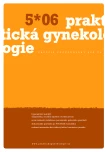New options for treatment of disturbances of balance of vaginal environment
Authors:
doc. MUDr. Vít Unzeitig; CSc. 1,2; MUDr. Hafez Al Awad 2
Authors‘ workplace:
Centrum ambulantní gynekologie a porodnictví, Brno
1; Gynekologicko-porodnická klinika LF MU a FN Brno
2
Published in:
Prakt Gyn 2006; 10(5): 170-173
Overview
Objective:
A prospective study of changes in vaginal environment in patients with chronic and recurrent vaginal discharge and vaginal discomfort.
Material and method:
The set consisted of 100 women of fertile age. The condition for inclusion in the study was a history of four or more instances of vaginal discomfort (except for those of trichomonal or chlamydial origin) in the preceding 12 months. In month 1, native smears were read on a repeated basis and vaginal pH was measured without any broad-spectrum or local medication. In the subsequent 2 months, the same tests were performed to monitor the women on tailored vaginal therapy. 50 women of fertile age have been monitored on a long-term basis. Results: A significant stabilization of vaginal environment was recorded for 86% of women of fertile age, of which two thirds reported a dramatic and 20% a slight improvement in their long-term clinical problems, respectively.
Discussion:
The vaginal ecosystem is extremely sensitive to hormonal and biochemical changes in a woman's body. The authors' objective was to find a simple and cost-effective way for the patient herself to balance her vaginal environment, and to monitor further development of her vulvovaginal subjective and clinical problems over a subsequent period of six months.
Conclusion:
Results of the study have provided evidence for the efficiency of combined vaginal medication the final biochemical effect of which contributes to significant stabilization of the vaginal environment.
Key words:
vaginal discomfort – chronic and recurring discharge – vaginal ecosystem – vulvovaginal problems – combined vaginal medication – benyidamid – lactobacillus acidophillus – estriol
Sources
1. Boris S, Arbes C. Role played by lactobacilli in controlling the population of vaginal pathogens. Microbes Infect 2000; 2: 543–546.
2. Cibula D, Henzl MR, Živný J et al. Základy gynekologické endokrinologie. Praha: Grada Publishing 2002: 340.
3. Hawes SE, Hillier SL, Benedetti J et al. Hydrogen peroxide producing lactobacilli and acquisition of vaginal infections. J Infect Dis 1996; 174: 1058-1063.
4. Ozkinay E, Terek MC, Yayci M et al. The effectiveness of live lactobacilli in combination with low dose oestriol to restore the vaginal flora after treatment of vaginal infections. Br J Obstet Gynaecol 2005: 112: 234–240.
5. Unzeitig V. Záněty. In: Rob L (ed). Gynekologie. Praha: Galén 2006: 201-215.
Labels
Paediatric gynaecology Gynaecology and obstetrics Reproduction medicineArticle was published in
Practical Gynecology

2006 Issue 5
Most read in this issue
- New options for treatment of disturbances of balance of vaginal environment
- Extrauterine pregnancy after IVF/TESE: casuistic
- New aspects in diagnosis and pathophysiology of polycystic ovarian syndrome
- The family Anamnesis as the Risk Factor of the Breast Cancer
